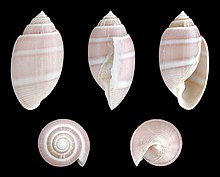Wood turning worm
| Wood turning worm | ||||||||||||
|---|---|---|---|---|---|---|---|---|---|---|---|---|

Wood turning snail ( Acteon tornatilis ) |
||||||||||||
| Systematics | ||||||||||||
|
||||||||||||
| Scientific name | ||||||||||||
| Acteon tornatilis | ||||||||||||
| ( Linnaeus , 1758) |
The turning screw , also Tönnchenschnecke ( Acteon tornatilis ) is a snail from the family Acteonidae in the order of cephalaspidea (Cephalaspidea), which in the northeastern Atlantic Ocean and the Mediterranean is widespread and of polychaete malnourished.
features
The egg-shaped, solid, shiny and opaque snail shell of Acteon tornatilis , which can grow up to 2.5 cm in adult snails, is sculpted with transverse ribs and sometimes also visible spiral lines. The case mouth takes up about two thirds of the case length. There is a pin on the inside of the spindle. The surface of the shell is pink to brown with white bands around the shell, which have a slightly darker pink border on each side. There are two bands on the perimeter of the body, one band on the other perimeters.
The triangular, clear operculum is amber-like in color with fine lines spreading out from the edge.
The snail's large, fleshy, cream-colored body can be fully retracted into its shell. The head and foot are divided in front, with the head having large and the foot small lobes. There are also small, blunt antennae on the propodium of the foot.
distribution
Acteon tornatilis is found in sheltered sandy bays in the North Sea , off Iceland , the Faroe Islands , Shetland , Norway and from the Atlantic coast of France in the Mediterranean to the Aegean Sea .
habitat
The snail digs in pure sand in the lower intertidal zone and the shallower zones below, where its prey, various tube worms , live in the substrate.
Life cycle
Wood turning snails are hermaphrodites that mate with their penises . The mating takes place in spring and autumn, after which club-shaped, approximately 6 cm long egg clutches are laid on the surface of the sediment by both partners. They can either be attached to aquatic plants or stones, or buried in the sediment. Veliger larvae hatch from the eggs, feed on plankton and later metamorphose into juvenile snails .
food
The wood turning snail feeds on polychaetes , whereby the tube worms Lanice conchilega and Owenia fusiformis are preferred as prey , but Owenia fusiformis with its short living tubes is easier for the snail to capture. The eating process can take hours.
literature
- John D. Fish, Susan Fish: A Student's Guide to the Seashore . Cambridge University Press, Cambridge 2011. 540 pages. Opisthobranchs with an obvious external shell: Acteon tornatilis (Linnaeus) , p. 226.
Web links
- MJ de Kluijver, SS Ingalsuo & RH de Bruyne: Acteon tornatilis (Linné, 1758). Mollusca of the North Sea, Marine Species Identification Portal
- Fischhaus Zepkow: Family Acteonidae - wood turning snails
- Marine Life Information Network: Acteon tornatilis
- World Register of Marine Species , World Marine Mollusca database: Acteon tornatilis (Linnaeus, 1758)
Individual evidence
- ↑ Nathalie Yonow (1989): Feeding observations on Acteon tornatilis (Linnaeus) (Opisthobranchia: Acteonidae). Journal of Molluscan Studies 55, pp. 97-102.

